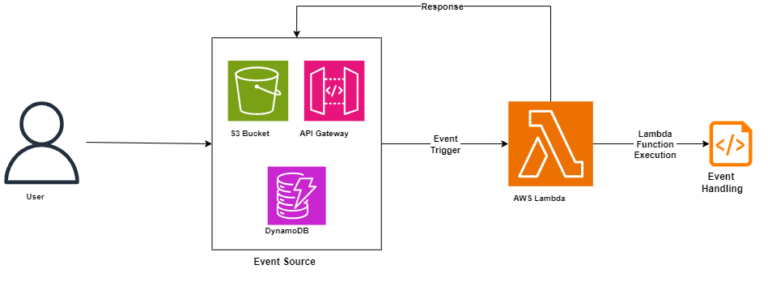AWS Lambda: A Comprehensive Guide
Introduction
In today’s fast-paced world of cloud computing, the ability to execute code without provisioning or managing servers is a significant advantage. AWS Lambda, a serverless computing service provided by Amazon Web Services (AWS), offers this capability. This comprehensive guide will delve into the main aspects of AWS Lambda, exploring its features, use cases, benefits, and limitations.
This blog will guide you through the essential aspects of AWS Lambda, covering the following topics:
- What is AWS Lambda?
- How does AWS Lambda work?
- Key Features of AWS Lambda
- Supported Languages and Runtimes
- Benefits of Using AWS Lambda
- Limitations of AWS Lambda
- AWS Lambda Pricing
What is AWS Lambda?

AWS Lambda is a serverless compute service provided by Amazon Web Services (AWS) introduced on November 13, 2014. It allows us to run code without provisioning or managing servers. With the help Lambda Function service, we can easily execute our code in response to events such as changes in data, shifts in system state, or actions taken by users.
AWS Lambda is an event-driven, serverless Function as a Service (FaaS). This service automatically scales the application by running code in response to each trigger. This makes it a powerful tool for building event-driven architectures.
How Does AWS Lambda Work?
AWS Lambda operates on an event-driven model, where functions (small pieces of code) are executed in response to events from other AWS services or custom triggers. Here’s overview of the steps that how this service works:
- Event Source: An event source is an AWS service or a custom application that generates events. Common event sources include S3 (file uploads), DynamoDB (table updates), and API Gateway (HTTP requests).
- Event Trigger: When an event occurs, it triggers the Lambda function. We configure these triggers when setting up the Lambda function.
- Lambda Function Execution: The triggered event invokes the Lambda function. AWS Lambda then provisions the necessary compute resources, runs the code, and scales automatically based on the volume of requests.
- Event Handling: The Lambda function processes the event, performing the required operations such as data processing, transformation, or interacting with other AWS services.
- Response: After processing the event, the Lambda function returns a response or completes the task, and the compute resources are automatically scaled down.

Key Features of AWS Lambda
- Event-Driven Architecture: Lambda functions can be triggered by various AWS services, making it ideal for building event-driven applications.
- Automatic Scaling: Lambda automatically scales the application by running code in response to each trigger, ensuring optimal performance regardless of workload.
- Pay-As-You-Go: We pay only for the compute time we consume—there is no charge when our code is not running, making it a cost-effective solution.
- Integrated Security: Lambda integrates with AWS Identity and Access Management (IAM) to provide fine-grained access control.
- Ease of Deployment: Supports various programming languages and runtime environments, allowing developers to use their preferred languages and tools.
Supported Languages and Runtimes
AWS Lambda supports several programming languages and runtime environments, enabling developers to use familiar tools and libraries. The supported languages include:
- Node.js
- Python
- Ruby
- Java
- Go
- .NET Core
- Custom Runtime: We can also bring our own runtime if our preferred language is not natively supported by using AWS Lambda’s custom runtime capability.
Benefits of Using AWS Lambda
- Reduced Operational Overhead: No need to manage servers or infrastructure, allowing us to focus on writing code.
- Cost Efficiency: Pay only for the compute time we use, with no charges for idle time. Lambda’s pricing model can significantly reduce costs for many applications.
- Scalability: Automatic scaling to handle any volume of requests, ensuring high availability and performance.
- Flexibility: Support for multiple programming languages and seamless integration with other AWS services.
- Security: Built-in security features, including integration with IAM, for fine-grained access control and secure environment management.
Limitations of AWS Lambda
- Execution Time Limits: Lambda functions have a maximum execution timeout of 15 minutes, which might not be suitable for long-running tasks.
- Resource Limits: There are limits on the amount of memory (up to 10 GB) and temporary disk space (512 MB) that a Lambda function can use.
- Cold Starts: Initial invocation of a Lambda function can experience a latency due to the cold start, where the service provisions the necessary resources.
- Complexity in State Management: Maintaining state across function invocations can be challenging and might require additional services like DynamoDB or S3.
AWS Lambda Pricing
AWS Lambda pricing is based on the compute time and the number of requests. The key components of the pricing model include:
- Compute Time: We are charged based on the number of requests for our functions and the time your code executes. Lambda counts a request each time it starts executing in response to an event notification or an invoke call.
- Request Pricing: The first 1 million requests per month are free. After that, you are charged per million requests.
- Duration Pricing: We are charged based on the amount of memory we allocate to our function and the time it takes to execute. The duration is calculated from the time our code begins executing until it returns or otherwise terminates, rounded up to the nearest 1 millisecond.
- Additional Costs: There may be additional costs if our Lambda function interacts with other AWS services, such as data transfer charges or storage fees for using services like S3 or DynamoDB.
Conclusion
AWS Lambda provides a robust, scalable, and cost-effective solution for running code in response to events without the need to manage infrastructure. By understanding its features, benefits, limitations, and pricing, we can leverage Lambda to build powerful serverless applications and streamline our cloud computing architecture.
By – Dheeraj Sain